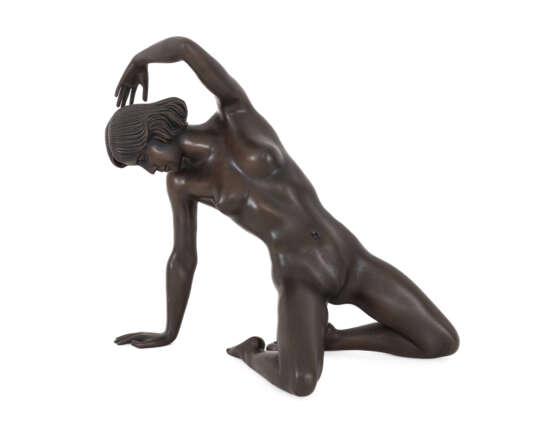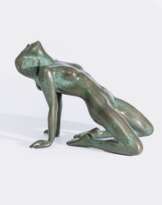ID 847262
Lot 39 | Arno Breker (1900 Elberfeld - 1991 Düsseldorf) (F)
Estimate value
€ 1 600
'Grazie', 1979, Bronze, braun patiniert, Höhe 25,5 cm, im Guss signiert, Gießerstempel, 73/300 nummeriert, partiell leicht berieben, minimal Grünspan, Zertifikat anbei, Provenienz: Galerie Richard P. Hartmann, München.
Der deutsche Bildhauer und Architekt Arno Breker wurde am 19. Juli 1900 in Wuppertal geboren. 1920 begann Breker sein Studium an der Düsseldorfer Kunstakademie. Sein großes Idol war der französische Bildhauer Auguste Rodin. Das Jahr 1936 bezeichnete der Künstler als Wendepunkt in seinem Leben. Die deutliche Anlehnung seiner Plastiken an die Antike erregte den Gefallen der Nationalsozialisten. Auf einmal erhielt Breker Aufträge und Auszeichnungen, trat 1937 in die NSDAP ein und wurde schnell als "Michelangelo des Dritten Reichs" gefeiert. So erhielt er 1938 den Auftrag die Büste Adolfs Hitlers zu fertigen. Nicht nur von den Nationalsozialisten, auch von dem französischen Vichy-Regime wurde der Künstler hoch angesehen. Nach Ende des Zweiten Weltkrieges floh Breker nach Bayern, wo er im Rahmen der Entnazifizierung freigesprochen wurde. Er erhielt zahlreiche private Aufträge, porträtierte viele namhafte Industrielle wie Hugo Henkel, Herbert Quandt und Rudolf-August Oetker, sowie die Politiker Konrad Adenauer und Ludwig Erhard. Ebenfalls wurde er mit Architekturprojekten wie dem Bau der Büro- und Wohngebäude für den Gerling-Konzern in Hagen 1955 beauftragt. Trotz zahlreicher Aufträge erhob sich in der Nachkriegszeit auch Kritik gegen den Künstler und seine idealisierende Ästhetik. Dennoch war Breker in der internationalen Künstlerwelt der Nachkriegszeit bekannt und pflegte besondere Freundschaft mit Salvador Dalí und Ernst Fuchs. Dalí sagte einst über die drei Künstler, die zusammen als "Goldenes Dreieck" bezeichnet wurden: "Breker-Dalí-Fuchs. Man kann uns wenden wie man will, wir sind immer oben." In seinen Arbeiten beschäftigte sich Breker zeitlebens mit dem menschlichen Körper in seiner vollen Schönheit. Ernst Fuchs beschrieb ihn sogar als "der wahre Prophet des Schönen". Der sinnlich-sinnende Mädchenakt "Grazie" ist ein besonders harmonisches Beispiel seines den Realismus mit dem Idealismus verbindenden Stils.
Arno Breker (1900 Elberfeld - 1991 Düsseldorf) (F)
'Grazie', 1979, bronze, brown patina, height 25,5 cm, signed in the casting, foundry stamp, numbered 73/300, partially slightly rubbed, minimal verdigris, certificate enclosed, Provenance: Galerie Richard P. Hartmann, Munich.
The German sculptor and architect Arno Breker was born in Wuppertal on 19 July 1900. In 1920 Breker began his studies at the Düsseldorf Art Academy. His great idol was the French sculptor Auguste Rodin. The artist described 1936 as a turning point in his life. The clear allusion of his sculptures to antiquity attracted the favour of the National Socialists. Suddenly Breker was receiving commissions and awards, joined the NSDAP in 1937 and was quickly celebrated as the ''Michelangelo of the Third Reich''. In 1938, for example, he was commissioned to make the bust of Adolf Hitler. The artist was highly respected not only by the National Socialists, but also by the French Vichy regime. After the end of the Second World War, Breker fled to Bavaria, where he was acquitted in the denazification process. He received numerous private commissions, portrayed many well-known industrialists such as Hugo Henkel, Herbert Quandt and Rudolf-August Oetker, as well as the politicians Konrad Adenauer and Ludwig Erhard. He was also commissioned with architectural projects such as the construction of the office and residential buildings for the Gerling Group in Hagen in 1955. Despite numerous commissions, criticism also arose against the artist and his idealising aesthetics in the post-war period. Nevertheless, Breker was well-known in the international art world of the post-war period and cultivated special friendships with Salvador Dalí and Ernst Fuchs. Dalí once said of the three artists, who together were known as the ''Golden Triangle'': ''Breker-Dalí-Fuchs. You can turn us any way you like, we are always on top.'' In his work, Breker was concerned throughout his life with the human body in all its beauty. Ernst Fuchs even described him as ''the true prophet of the beautiful''. The sensual, sensuous girl nude ''Grazie'' is a particularly harmonious example of his style combining realism with idealism.
| Artist: | Arno Breker (1900 - 1991) |
|---|---|
| Auction house category: | Sculptures |
| Artist: | Arno Breker (1900 - 1991) |
|---|---|
| Auction house category: | Sculptures |
| Address of auction |
WETTMANN | Auktionshaus an der Ruhr Friedrichstraße 67-67a 45468 Mülheim an der Ruhr Germany | ||||||||||||||
|---|---|---|---|---|---|---|---|---|---|---|---|---|---|---|---|
| Preview |
| ||||||||||||||
| Phone | +49 (0)208 3059081 | ||||||||||||||
| Fax | +49 (0)208 4391735 | ||||||||||||||
| Buyer Premium | 30% | ||||||||||||||
| Conditions of purchase | Conditions of purchase | ||||||||||||||
| Business hours | Business hours
|














